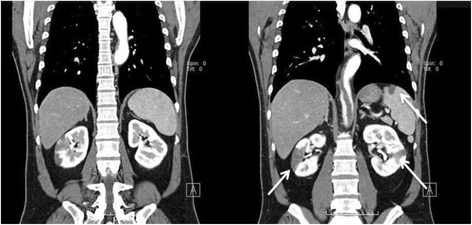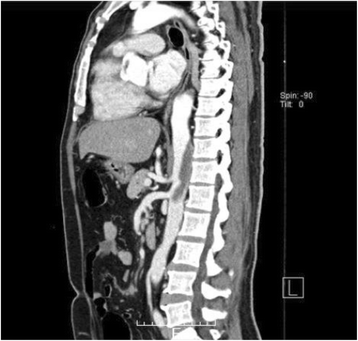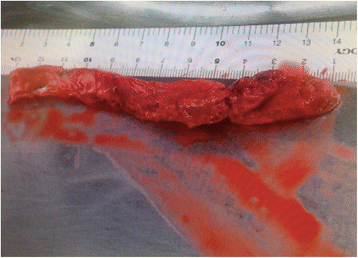Surgical treatment for thoracoabdominal intra-aortic thrombus with multiple infarctions: a case report
- PMID: 27510310
- PMCID: PMC4980792
- DOI: 10.1186/s13256-016-1017-1
Surgical treatment for thoracoabdominal intra-aortic thrombus with multiple infarctions: a case report
Abstract
Background: Mobile intra-aortic thrombus without atherosclerosis, aneurysm, or congenital coagulopathy is very rare, and there are few reports especially in young or middle-aged patients. Furthermore, there are presently no established guidelines or common strategies for the treatment of mobile intra-aortic thrombus. In this case report, we describe the first case of intra-aortic thrombus caused by secondary erythrocytosis and describe the recommended treatment strategy for intra-aortic thrombus.
Case presentation: We report a case of an independent 40-year-old Asian man with a current history of heavy cigarette smoking who had sudden onset of abdominal and lumbar pain. Contrast-enhanced computed tomography revealed partial renal and splenic infarction, and he was transferred to our hospital. He also had a large mural thrombus in his thoracoabdominal aorta. Blood analysis on admission showed a hemoglobin level of 19.4 g/dL and hematocrit of 54.3 %; his international normalized ratio of prothrombin time, fibrin degradation products, and activated partial thromboplastin time levels were 1.02, 2.8 μg/ml, and 26.9 seconds respectively. We could find no abnormalities in protein C and protein S activity levels. Lupus anticoagulant and anti-cardiolipin antibody were both negative. He had no past medical history of arrhythmia and we found no signs of an arrhythmic event during admission. We promptly started anticoagulant therapy, but as the thrombus seemed at high risk of causing further critical infarction, we performed emergency aortic thrombectomy using partial extracorporeal circulation. To prevent dissemination of the thrombus during extracorporeal circulation, we first clamped his proximal and distal aorta on either side of the thrombus just before initiating extracorporeal circulation. After the aortotomy we removed a 14-cm length of intra-aortic thrombus without residual lesion. He was discharged from our hospital 20 days after surgery. From the results of his blood analysis, we considered the only cause of this thrombus was secondary erythrocytosis, which was probably induced by his current heavy cigarette smoking.
Conclusion: We are the first to report such a thrombosis caused by secondary erythrocytosis and conclude that once the diagnosis of intra-aortic thrombus with systemic embolism is clear, emergency surgical removal of such a thrombus must be considered to prevent further embolic complications.
Keywords: Erythrocytosis; Infarction; Intra-aortic thrombus; Surgical thrombectomy.
Figures




Similar articles
-
[Splenic infarction caused by supra-celiac aortic thrombus. Two case reports].Rev Port Cir Cardiotorac Vasc. 2008 Jan-Mar;15(1):59-62. Rev Port Cir Cardiotorac Vasc. 2008. PMID: 18618052 Portuguese.
-
Successful Thrombectomy for an Idiopathic Floating Ascending Aortic Thrombus.Ann Thorac Surg. 2016 Sep;102(3):e245-e247. doi: 10.1016/j.athoracsur.2016.01.075. Ann Thorac Surg. 2016. PMID: 27549555
-
Thoracoabdominal aortic mural and floating thrombus extending into superior mesenteric artery.J Med Ultrason (2001). 2018 Jul;45(3):539-542. doi: 10.1007/s10396-017-0848-8. Epub 2017 Dec 13. J Med Ultrason (2001). 2018. PMID: 29236196
-
Repeated acute coronary syndrome caused by a mind-bending mural thrombus in ascending aorta: a case report and review of the literature.BMC Cardiovasc Disord. 2024 May 29;24(1):281. doi: 10.1186/s12872-024-03956-2. BMC Cardiovasc Disord. 2024. PMID: 38811879 Free PMC article. Review.
-
Descending thoracic aortic mural thrombus presentation and treatment strategies.J Vasc Surg. 2017 Sep;66(3):931-936. doi: 10.1016/j.jvs.2017.05.109. Epub 2017 Jul 25. J Vasc Surg. 2017. PMID: 28754361 Review.
References
-
- Soleimani A, Marzban M, Sahebjam M, Shirani S, Sotoudeh-Anvari M, Abbasi A. Floating thrombus in the aortic arch as an origin of simultaneous peripheral emboli. J Card Surg. 2008;23:762–4. - PubMed
-
- Towne JB. Hypercoagulable states and unexplained vascular thrombosis. 3. St. Louis: Quality Medical Publishing; 1991. pp. 101–18.
-
- Wiman B. The role of the fibrinolytic system in thrombotic disease. Acta Med Scand Suppl. 1987;715:169–71. - PubMed
Publication types
MeSH terms
Substances
LinkOut - more resources
Full Text Sources
Other Literature Sources
Medical
Miscellaneous

